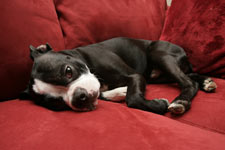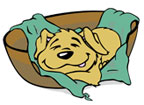Boston Terrier Dog Breed
Dog Group: Non-Sporting Group
Class: Non-Sporting
Description

The Boston Terrier is a fairly small, yet sturdy and muscular dog with a short, wide muzzle and a very intelligent, understanding expression. This breed has wallowing dark eyes that give the Boston Terrier a deep and meaningful look. The Boston Terrier has a sleek, hard and very straight coat that comes in brindle and white or black and white. Its distinctive ears stand erect and are quite large, and the eyes are set quite wide apart.
Temperament
The temperament of the Boston Terrier is so gentle and well-mannered that it is often referred to as the ‘American gentleman amongst dogs’. This is a very affectionate and loving breed, which combines intelligence and eagerness with a mild manner and fierce loyalty. The Boston Terrier likes nothing better than to be a real part of the family and getting lots of attention and love. This breed is suited to children and the elderly, and loves to meet strangers. A well-socialized Boston will get on with other dogs and family pets. They enjoy exercise and play, but cannot tolerate extreme temperatures and hate being alone.
Height and Weight
The Boston Terrier is a small but nevertheless sturdy dog, and can reach around 10-25 pounds in weight. The height of a Boston Terrier can reach around 15-17 inches.
Common Health and Behavioral Problems
Because of the short muzzle, the Boston Terrier has a tendency to snore and can suffer shortness of breath quite quickly. Because the eyes protrude slightly, they can be at risk from infection, dryness and other ocular problems. The breed has also been known to be at increased risk from heart and skin tumors. One thing to bear in mind is that the Boston Terrier is a dog that loves – often craves – the company of others, and you may find that some Boston Terriers will suffer from separation anxiety.
Ideal Living Conditions
The Boston Terrier is an indoor dog that needs moderate temperatures and plenty of affection and attention. The breed is suited to both houses and apartments, and exercise can entail a running and playing in the garden (if you have one) as well as walks and plenty of interactive games.
Exercise Requirements
The Boston Terrier enjoys moderate exercise, and likes to go for walks. However, interactive play provides him with the company he craves as well as healthy exercise. You should not push the Boston Terrier to exercise outside in extreme temperatures as he cannot tolerate intense heat or cold, and you should remember that he may have difficult breathing due to his short muzzle so avoid anything too strenuous.
Diet and Nutrition
The Boston Terrier can be greedy, and his food portions should therefore be monitored to avoid weight gain and other health issues. A dry, quality dog food fed twice daily will provide the necessary nutrient and keep your dog’s teeth in good condition. As with all dogs, there should always be access to fresh, clean water.
Life Expectancy
A healthy Boston Terrier can live well in to his teens, and the average lifespan is around 13-15 years. Obviously, general overall health, diet, and living conditions will contribute to the individual dog’s lifespan.
Grooming Requirements
Maintenance of the Boston Terrier’s coat is relatively simple, as it is a short, sleek coat. A firm bristle brush can be used to keep the coat healthy, and this can be coupled with the occasional use of dry shampoo and a wipe-down with a damp cloth. An occasional bath is okay when necessary, and you should take the opportunity to check the eyes and skin for any signs of infection or problems. The nails of the Boston Terrier will also need to be trimmed occasionally, so keep a check on nail growth.
Origin
The Boston Terrier originates from the Unites States and is thought to have originated from the French Bulldog and White English Terrier. This breed was originally bred for fighting, and there was much controversy when nineteenth-century bulldog fanciers tried to discredit the breed, stating that it was neither bulldog nor terrier (the breed was then known as bulldog terriers). However, the breed reigned victorious when, having been renamed the Boston Terrier, it was finally registered by the American Kennel Club in 1893. It has now become one of the most popular breeds in the United States.
 |
 |
Secrets to Dog Training: Consultation
Secrets to Dog Training offers a free consultation with every order! Here is one submitted by Barb about a rescued Boston Terrier, Zane...
Barb's Consultation
Hi there,
I'm taking advantage of your free consultation. My family and I have recently rescued a Boston Terrier named Zane. Zane is 6 years old and we don't know much about his history. He has been a pretty well behaved addition to our family and great with my two boys (ages 4 and 6). We've had him for about two months now.
My problem has come when I've taken him out on walks( on lead). I walk him everyday. On two occasions he has bitten someone. I've been fortunate that the people he has bitten have been very forgiving but I'm now nervous about walking him and terrified at the possibility of him getting out off leash. We just got through the Holidays with many people coming and going and he did a great job... indoors. I'm not sure what it is that set him off those two times. We definitely cannot have a third. Thanks for your help,
Barb
Secrets to Dog Training Reply:
Hi Barb,
Thank you for your email regarding your 6 year old Boston Terrier. From what you have told me, no you cannot really afford for this behavior to carry on any longer. In fact you are very fortunate those that have been bitten have been as forgiving as you say. It is very important for us to tackle this problem right now and stop any more situations like this occurring again.
Firstly I think it is very important (at least for the next little while), to make Zane wear a muzzle in public. You can buy these relatively inexpensively from pet stores and they will be able to help you find one for the short faced terrier breads. By making Zane wear this will ENSURE that something similar doesn’t happen again while you are re-training him.
From what you have stated in your email and from the nature of his behavior it sounds as though the two times he has bitten people on walks could be due to a territorial aggression problem that has also spread to include aggression to dogs and people he sees in the neighborhood during walks. Perhaps you should try to avoid the problem to begin with by choosing ‘quiet’ times to walk your dog – i.e. early mornings and late evenings.
From your email it sounds as though Zane is generally very well behaved. Despite this I would recommend that you start re-training him on a regular basis and under a variety of conditions. The progression below is a useful one that many people have used to get better results from their dogs. The first step is to have your training session in an environment where Zane is comfortable and not threatened. You can decide where you start on the progression if you feel that you would get a good response out of the earlier progressions and do not need to do it again.
You will also be the best judge of when you should move on to the next progression, but I would recommend that you move on when your dog completes a 5 to 10 minute sit-stay and a 5-10 minute down-stay. This may require you to go back to the beginning to quite basic commands but you are better to take things slowly and complete this program over a number of weeks.
1. inside, on-leash, with no other dogs or people present,
2. outside, on-leash, with no other dogs or people present,
3. outside, off-leash, with no other dogs or people present,
4. outside, on-leash, gradually introducing dogs and people to the vicinity,
5. outside, off-leash, gradually introducing dogs and people to the vicinity.
Try to minimize the contact Zane has with strangers and those people he meets during his walks – even if he has been muzzled. The more exposure your dog gets to confrontational situations the harder your problem will be to fix.
Outside of training it may be worth trying to socialize your dog a bit more preferably with friends and family who would be forgiving if there was a slight nip! In saying that, if you think that your dog may react badly by biting then consider using a muzzle even in these socializing situations.
Again, this will have to be a gradual process where the new person/people is/are introduced at a neutral venue and from a distance. By that I mean you should get Zane to sit and have the person in his sight but a long way away. You want to keep your dog’s focus and attention on you as your friend gradually comes closer.
By reprimanding all bad behaviors Zane exhibits and rewarding behaviors where he would otherwise have been bad usually, his all round behavior should improve. Use the commands you have taught him when walking him, use a muzzle and short lead if initially and resist tightening your grip on his leash when you see another dog or person approach.
Best of luck with Zane. It sounds like ultimately he is a very well behaved dog that for some reason has lashed out on two occasions. You should be thankful that no further action was taken, and act quickly now to nip this problem in the bud, before it either gets worse or leads to any bites. Ensure that you and your family are “Alpha” over Zane also, by reading or re-reading the bonus book “Secrets to Becoming the Alpha Dog”. This may also help the problem, however I still believe it has something to do with a territorial aggression and the methods above will help the most in aiding this particular problem.
Thanks again for your email. Let us know how you get on with Zane over the next couple of months.
Kind regards,
Daniel Steven and the Secrets to Dog Training Team
"Secrets to Dog Training - STOP Dog Behavior Problems!"
More Resources
 |
 |
Want to find out about more dog breeds? Search here or go to our Dog Breed index.
Got Dog Obedience Training or Problem Behavior Issues?
Is your dog trying your patience on a daily basis? Are you constantly faced with a dog that displays one of the following issues? To find the solution to your problem click on it.. you'll discover the answers to it and other common dog problems you may be facing.
This is the most comprehensive book on dog training and behavior problems around. Best of all... You can download this book to your computer and be reading and using the professionals training techniques in minutes.
About The Author
Daniel Stevens is the renowned dog trainer and author of Secrets to Dog Training: STOP Dog Behavior Problems!, one of the leading dog training guides on the market today selling over 25,743 copies (and counting). He currently heads the Kingdom of Pets dog training team.

